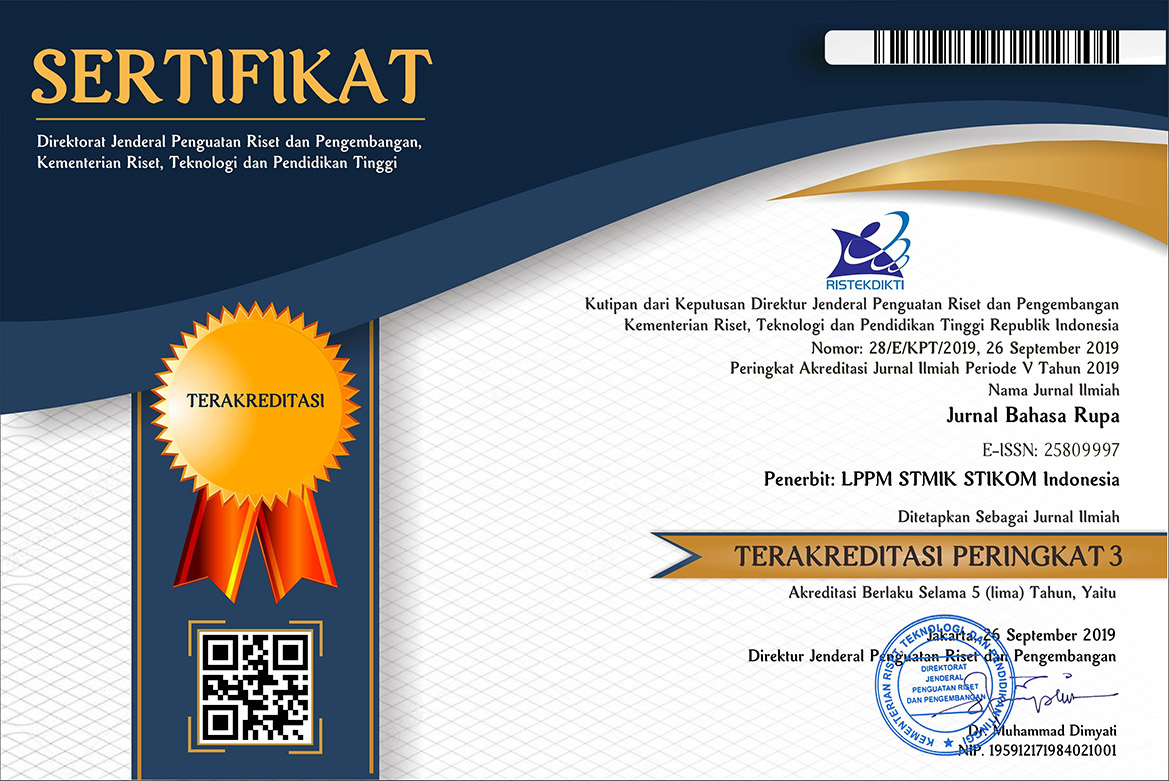Desain Mural Sebagai Media Komunikasi Visual Perwujudan Destination Branding Desa Wisata Bongan
DOI:
https://doi.org/10.31598/bahasarupa.v6i1.1080Keywords:
mural, visual communication media, destination branding, tourism villageAbstract
Destination Branding is an effort to identify and introduce the potential of a destination, in order to build the identity of a destination against public perception through information and communication media. Bongan Village is one of the tourist villages in the Tabanan Regency which has the potential for its natural, historical, and cultural wealth that can become a leading tourist destination. So, it is important to realize destination branding for Bongan Tourism Village in order to introduce its superior potential through the right communication media. The purpose of realizing this destination branding is to inflame the superior potential of Bongan Tourism Village to the public and tourists through mural design as a medium of communication. The research method used in realizing this destination branding is by conducting observations and direct field interviews through descriptive methods. With the application of this method, it is known that there is a public space in the Bongan Tourism Village area that is appropriate and worthy of being used as a communication medium, in which a communicative mural design can be implemented. Murals, which are often seen as street art, are a choice of media that can communicate and convey information visually in public spaces.
Downloads
References
D. Y. Yurisma, “Kesenian Tradisi Reog Sebagai Pembentuk Citra Ponorogo,” Visualitas, vol. 7, no. 1, pp. 1–15, 2018, [Online]. Available: https://ojs.unikom.ac.id/index.php/visualita/article/view/1081/pdf
C. Blain, S. E. Levy, and J. R. B. Ritchie, “Destination branding: Insights and practices from destination management organizations,” J. Travel Res., vol. 43, no. 4, pp. 328–338, 2005, doi: 10.1177/0047287505274646.
S. S. Hadiwijoyo, Perencanaan Pariwisata Pedesaan Berbasis Masyarakat. Yogyakarta: Graha Ilmu, 2012.
O. B. Wicandra, “Berkomunikasi Secara Visual Melalui Mural Di Jogjakarta,” Nirmana, vol. 7, no. 2, pp. 126–133, 2005, [Online]. Available: http://puslit2.petra.ac.id/ejournal/index.php/dkv/article/view/16518
E. Irwandi and S. Sabana, “Proses Perwujudan Identitas Tempat Melalui Seni Mural,” Pros. Semin. Nas. Desain dan Arsit., vol. 2, pp. 70–76, 2019, [Online]. Available: www.merriam-webster.com.
Y. Pusparani, “Perencanaan Destination Branding Melalui Mural di Desa Wisata , Desa Sumber Harapan , Kalimantan Barat ( Destination Branding Planning Through Mural In Desa Wisata , Desa,” pp. 353–363, 2019.
Sugiyono, Metode Penelitian Kombinasi (Mixed Metods). 2012.
N. L. Rahmawati, “Pengaruh City Branding terhadap Image Of Urban Destination dan Dampaknya pada Post-Visit Behavior,” Trikonomika, vol. 14, no. 1, p. 66, 2015, doi: 10.23969/trikonomika.v14i1.593.
M. Gazali, “Jurnal Imajinasi,” J. Imajin., vol. XII, no. 1, 2017.
I. G. Y. Pratama, “Pelestarian Permainan Tradisional Bali Melalui Mural Di Lapangan Astagina,” J. Lentera Widya, vol. 3, no. 1, pp. 43–49, 2021, doi: 10.35886/lenterawidya.v3i1.271.
S. Hardiyarso, “Etika Komunikasi Visual: Pencarian Kebenaran Dalam Pemahaman Antara Yang Dilihat Dan Yang Dipikirkan,” J. Komun. Dan Media, 2020.
I. G. Y. Pratama, “Kajian Bahasa Rupa Budaya Mesatua Bali Dalam Cerita Bergambar,” J. Bhs. Rupa, vol. 5, no. 1, pp. 112–121, 2021, doi: 10.31598/bahasarupa.v5i1.775.
Downloads
Published
How to Cite
Issue
Section
License
Copyright (c) 2022 I Gede Yudha Pratama

This work is licensed under a Creative Commons Attribution-NonCommercial-ShareAlike 4.0 International License.
The author's copyright in the Bahasa Rupa Journal, assigns that the publication of published articles is owned by the editorial board with the author's approval, but the rights are still with the author. The legal rules for accessing digital electronic articles are under license  Attribution-NonCommercial-ShareAlike 4.0 International (CC BY-NC-SA 4.0), which means that the Bahasa Rupa Journal has the right to store, modify, manage databases, maintain and publish articles without the author's permission, but the author as the copyright holder is still written as it is. Articles published in Bahasa Rupa Journals, both in hard and soft copy forms are available as open access, for educational, research and library purposes, and beyond that purpose, the editorial board of the Language and Language Journal is not responsible for illegal copyright infringement. This journal also applies LOCKSS and CLOKSS archiving.
Attribution-NonCommercial-ShareAlike 4.0 International (CC BY-NC-SA 4.0), which means that the Bahasa Rupa Journal has the right to store, modify, manage databases, maintain and publish articles without the author's permission, but the author as the copyright holder is still written as it is. Articles published in Bahasa Rupa Journals, both in hard and soft copy forms are available as open access, for educational, research and library purposes, and beyond that purpose, the editorial board of the Language and Language Journal is not responsible for illegal copyright infringement. This journal also applies LOCKSS and CLOKSS archiving.













.png)





